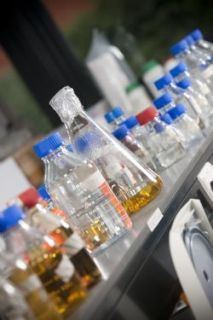Oct 24 2014
Cancer diagnostics and treatment options could be drastically improved with the creation of a ‘designer’ nanodevice being developed by researchers from the UK, Italy, the US and Argentina.
 Laboratory
Laboratory
The diagnostic ‘nanodecoder’, which will consist of self-assembled DNA and protein nanostructures, will greatly advance biomarker detection and provide accurate molecular characterisation enabling more detailed evaluation of how diseased tissues respond to therapies. A biomarker, or biological marker, refers to a measurable indicator of some biological state or condition. One example of a commonly used biomarker in medicine is prostate-specific antigen (PSA). This marker can be measured as a proxy of prostate size with rapid changes potentially indicating cancer.
The four-year ‘Immuno-NanoDecoder’ project involves lead partner University of Rome Tor Vergata, Italy; together with University of Lincoln, UK; Hospital of Udine, Italy; Temple University, Philadelphia, Pennsylvania; and University of Buenos Aires, Argentina.
The project’s long-term goal is to develop a molecular nanodevice for imaging of biomarkers in tissue samples and cells. It will initially help to accurately characterise skin cancers and glycogenosis type II (where the body cannot get rid of glycogen from the muscles), being especially useful to assess in vitro the effectiveness of experimental therapies.
It is funded with a 441,000 Euro grant from the Marie Skłodowska-Curie Research and Innovation Staff Exchange (RISE) programme.
The University of Lincoln team will be responsible for engineering and synthesising a key component of the nanodevice: a two way molecular connector to bind the protein part to the DNA scaffold.
Lincoln’s involvement will be led by Dr Enrico Ferrari from the School of Life Sciences, who specialises in assembling proteins, and Dr Ishwar Singh from the School of Pharmacy, who has expertise on DNA-binding molecules, have a number of hybrid molecular devices in mind.
Dr Ferrari, whose previous research led to the creation of a new bio-therapeutic molecule that could be used to treat neurological disorders, said: “Once a cancer has been diagnosed the next stage is to try various treatment methods, but it is often difficult to understand the specific effect of treatment. This nanodecoder is the perfect tool to be able to both diagnose cancer accurately and record therapeutic effects.
“Our hybrid nanodevice is an artificial device made out of DNA and protein. Molecules arranged in a very specific way can perform a function – this is what we are trying to achieve, in an artificial way. It’s like DNA origami; it’s possible to engineer different shaped molecules but we want to engineer molecules that also have a function. After this project, we will be in a position to claim we have a very well defined expertise to make hybrid molecular devices.”
Research will take place in the Peptide Suite within the University of Lincoln’s new state-of-the-art Joseph Banks Laboratories. The Suite was created following funding from The Royal Society and the University’s Research Investment Fund.
Using a high-resolution method called Atomic Force Microscopy the team will be able to look closely at the assembled nanodevice.
Dr Singh, whose research specialisms include antimicrobials, ‘biologics’ and DNA diagnostics, said: “Each nanodevice will be coupled to a specific molecular probe, such as an antibody, peptide, or protein that uniquely recognise disease biomarkers. The coupling will allow the nanodecoder to detect biomarker presence and distribution in cells and tissues using optical fluorescence microscopy – in other words making them shine. Different biomarkers can indicate whether the disease is in remission or where it may have spread. From this set of markers doctors can understand what the next step in the treatment process should be. The number of biomarkers that can be detected will be essentially unlimited and therefore the nanodecoder could serve as a platform to diagnose other cancers and diseases. This project is an excellent vehicle to test our molecular tools and understand the potential of our first hybrid device.”
The nanodecoder, once created, will be trialled at the University of Buenos Aires, Argentina and at the Hospital of Udine, Italy. Complementary research programs, ranging from nanotechnology to molecular medicine and pathology, will support the project.